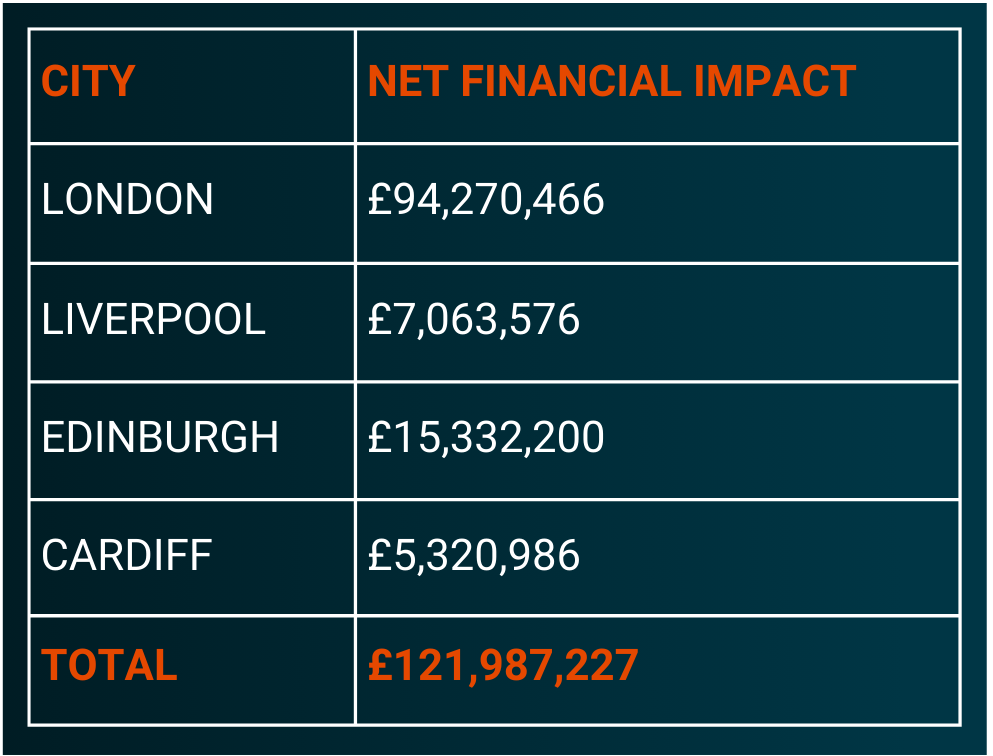
After months of anticipation, Taylor Swift has finally arrived in the UK and her Eras Tour is in full force. While Swifties are perfecting their outfits and prepping their bracelets, media and news outlets have started calculating what the economic contribution of the tour could be to the country.
The results are eye-watering. Reports of $92 million here1, $230 million there2 and even £1 billion has been dropped into the conversation3.
Just how realistic are these mind-boggling sums?
Despite our name, The Sports Consultancy doesn’t just work in sport – we specialise in live entertainment too. 2023 highlighted how the two industries collide when Kansas City Chiefs tight end and sporting megastar in his own right, Travis Kelce, was re-named “Taylor’s Swift’s boyfriend”. Swift attracted huge new fan groups and drove record engagement in the NFL4.

Using our experience conducting robust socio-economic impact assessments for the likes of the NFL, Formula 1 and World Athletics, we have looked at the economic impact of The Eras Tour and scrutinised some of the bold claims made about it across the world.
The Errors Tour
At TSC, we pride ourselves in creating evidenced based assessments that stand up to the scrutiny of public sector investors; recent studies have included assessments for NFL, UK Sport and the ICC. Equally, when we represent city bidders, we pour over the numbers ourselves to assess what the Return on Investment actually is.
It would therefore be remiss of us not to spend our kitchen discussions in the office debating whether the numbers are actually credible. So we challenged ourselves to produce a slightly more realistic guesstimate for the economic impact of Taylor Swift’s all-singing, all-dancing, economy-saving, cultural juggernaut to the UK.
Let’s do the Maths
Most reports showcasing the economic ‘contribution’ of The Eras Tour estimate this as the number of people in attendance multiplied by the total amount that they will spend to see their idol.

When both A and B are big numbers (lots of people willing to spend lots of money), then C is often a very big number that generates lots of clicks.
However, that big number does not quite translate into ‘economic boosts’ for host cities.
An ‘economic boost’ will only be caused by non-locals spending in the host city. Conversely, an ‘economic leakage’ will be caused by locals spending on ‘Swift Inc.’ (i.e., tickets and merch) instead of spending on local businesses.
In our calculations, we account for non-local boosts, and local leakages.
You Need To Calm Down
A recent Barclays survey predicts that Swifties will spend £848 on concert tickets, official merch, travel, accommodation, outfits, and more to attend the Eras Tour in the UK3.
However, spending on concert tickets and official merch does not contribute to the local economy, nor does spending on flights and other travel outside of the host cities. Once ‘non-Swift Inc.’ spending is accounted for, we are left with an average spend of £571 per fan.
Across the 15 UK shows, over 1.1 million tickets will likely be sold6. Of these, 452,000 are expected to be snapped up by either domestic or international tourists (i.e., the non-local fans)5.

We estimate that the combined net financial impact for the host cities will reach £122 million, across the 15 shows in London, Liverpool, Edinburgh, and Cardiff.

While this is not a billion pounds – a far cry from the ‘economy saver’ that Taylor Swift’s Tour is sometimes billed as7 – in a period of relatively low economic growth, this total is a valuable contribution to each region’s bottom line, as well as to ‘Brand UK’ through destination and tourism impacts.
It’s worth noting that the above impacts concern the direct spending only, with indirect and induced impacts being another matter entirely8…
The Prophecy
So when we ask ‘Can Taylor Swift Really Drive £1 billion to the UK Economy?’, it is clear that the answer is: no.
Equally, will The Eras Tour generate exactly £121,987,227.42 in additional economic activity for the four UK cities lucky enough to see the show this summer? Absolutely not.
Ultimately, what we do think is that Taylor Swift’s trip across the pond will likely provide a welcome direct financial injection to the order of £122 million, across London, Liverpool, Edinburgh, and Cardiff combined.
And we imagine those cities will be very happy with their Love Story indeed.
Sian Jenkins, Major Events & Campaigns Director says…
Entertainment drives impact; whether that’s Kelce on the pitch or Swift on the stage. Cities and Government know that and are willing to pay for the impact that entertainment provides.
Just take a look at Lee Hsien Loong’s deal for Singapore to be the only stop on Swift’s southeast Asia Eras tour. Whilst the specifics of the deal aren’t public, it’s clear that the country paid a substantial sum (from a government fund established to rebuild tourism after the pandemic) to ensure international visitors flocked to Singapore to see their idol.
The deal has been named controversial by some and strategic by others – but really it is no different from major sporting events who are able to capitalise on the impact they generate by driving significant rights fees.
The Sport Consultancy specialise in creating evidenced based impact reports that help cities invest in major events. If you would like to hear more about what we do, and who we have helped secure investment, please get in touch.

Footnotes
[1] Visit Cincy. (2023). ‘$92 Million in Local Spending Expected During Taylor Swift’s Two-Day ‘Eras Tour’ Stop in Cincinnati.’
[2] The Japan Times. (2024). ‘’Swiftonomics’ to yield ¥34.1 billion economic boost for Japan.’
[3] Barclays. (2024). ‘It’s a ‘Love Story’: Taylor Swift’s Eras Tour to provide nearly £1bn boost to UK economy.’
[4] Reuters. (2023). ‘The ‘Taylor Swift effect’ brings spending boost to football.’
[5] UK Music. (2023). ‘Here, There and Everywhere.’
UK Music finds that there is roughly a 60-40% split for local vs non-local attendees at UK concerts
[6] Total of UK Eras Tour = 1,175,470 tickets
Wembley Stadium, London = 90,000 x 8 dates = 720,000 tickets
Anfield Stadium, Liverpool = 54,000 x 3 dates = 162,000 tickets
Murrayfield Stadium, Edinburgh = 72,990 x 3 dates = 218,970 tickets
Principality Stadium, Cardiff = 74,500 x 1 date = 74,500 tickets
[7] Daily Mail. (2023). ‘Taylor Swift saved the US from recession and gave 50 truckers on her tour a £75,000 bonus each… No wonder the Wall Street Journal dubbed the phenomenon Taylornomics!’
[8] There are many ways to approach an economic impact assessment for a major event. For example, the inclusion of indirect and induced impact layers is common. These capture the ‘ripple’ effects that the additional non-local spending supports through the stimulation of domestic supply chains and employee wage payments.
TSC typically include these dynamics as part of formal impact assessments, however in this analysis, we have kept things simple and focussed on the direct impact layer only (i.e., the spend that can be directly attributed to non-local Swifties visiting each of the Tour’s host cities).
If included, it is not uncommon for these multiplier effects to result in a doubling of the total economic impact, relative to the direct layer alone. Therefore, if a formal impact assessment is conducted for the UK leg of The Eras Tour, and the wider effects of indirect and induced impacts are considered, a figure in the region of a quarter of a billion pounds could be established (for the financial contribution of the tour).
